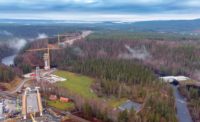

Constructing a single-story laboratory disguised as a 1,610-sq-ft office building—with interchangeable parts and systems for energy conservation performance mock-up tests—is novel but manageable. Constructing that building on a 64-ft-dia turntable, 100 yards from the Hayward Fault in earthquake-prone Berkeley, Calif., is undefined territory. So say members of the team building the world’s first revolving test bed—the centerpiece of the $15.7-million FLEXLAB at the U.S. Dept. of Energy’s Lawrence Berkeley National Laboratory.
The turntable test bed is a rectilinear shed that consists of mirror-image test cells, each measuring 20 x 30 ft. Once per minute, researchers can reset the orientation of the test building. The turntable rotates clockwise 270˚ from the southeast to the northeast to track the sun at its minimum speed of 1.8˚ per minute. It returns to 0˚ rotation by moving counterclockwise at its maximum speed of 18˚ per minute.
Scientists at FLEXLAB, which stands for Facility for Low Energy Buildings Research, needed the structure to to stay out of the way of the test cell walls because they wanted to be able to switch facade systems, says John Wolfe, an associate with FLEXLAB’s structural engineer, Tipping Mar. That meant no braces, no intermediate columns, and no horizontal members.
To resist seismic forces and still keep the facades “open,” Tipping Mar designed a lateral-load-resisting system of two rows of three, vertically cantilevered steel columns. Each row looks like a W but with three vertical legs and a horizontal base line.
At their base, the columns are connected to an orthogonal system of turntable floor girders through full-penetration welds. “It is an inverted moment frame,” says Wolfe.
All the lateral forces are drawn through the columns and girders into the center of the turntable, where there is a pivot foundation. Near its circumference, the turntable stands on 22 bogeys, which run in a circular track set 6 ft in from the turntable's perimeter.
The orthogonal system of girders caused some discomfort for Macton, the design-build turntable supplier, says Wolfe. “They had to go out of their comfort zone to leave a hub-and-spoke radial system,” he says.
Macton fabricated the structural-steel turntable platform, bogey wheels, rail, motor and controls, which were installed by local contractors, according to Steve Blankinship, project manager for FLEXLAB’s general contractor, C. Overaa & Co.
Tipping Mar is the engineer-of-record for FLEXLAB but not for the design-build portions of the turntable, which include the center-pin embedment plate and supporting center pin. Tipping Mar gave Macton the loads from the girder system to the bogeys and to the rotating equipment. Macton, which is based in Connecticut, was required to hire a California-licensed structural engineer for the design-build portions of the turntable. Forell Elsesser Engineers Inc. performed the engineering calculations for Macton.
The turntable design team eliminated the radial layout through careful coordination of the bogey wheel loads to the track. The bogeys are bigger and have more wheels under the heavier girders that transfer lateral loads from the columns to the pivot foundation.
Using a forklift, crews mechanically rotated the turntable for the first time on Aug. 4, during the installation of the steel platform. “We’ve rotated it several times a day [since], to get the alignments," says Blankinship.
By the end of the month, Overaa expects to have temporary power installed to rotate the turntable with the supplied motor. Due to its complexities, the 40%-complete turntable test bed is running about one month behind schedule, says Blankinship.
He hopes to pick up speed for a year-end completion, now that the most difficult parts of the turntable building are history. “I’ve never done a building that rotated,” says Blankinship. “We had to break it down into simpler components.”



Post a comment to this article
Report Abusive Comment